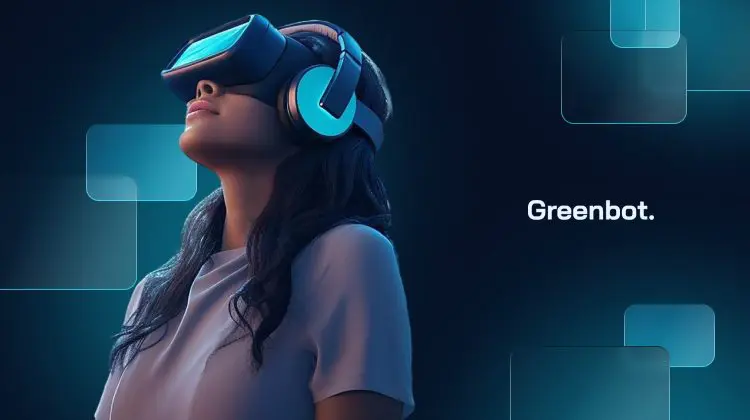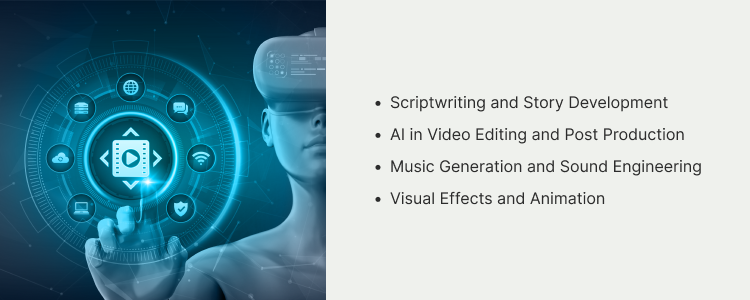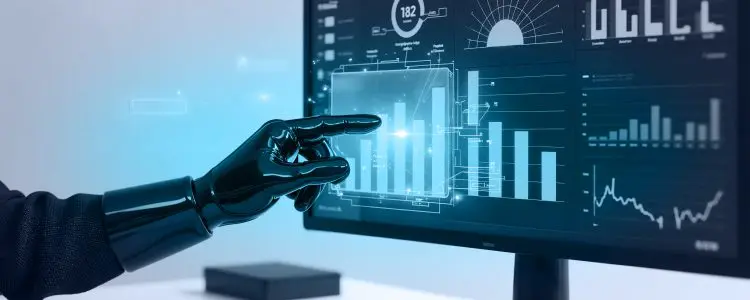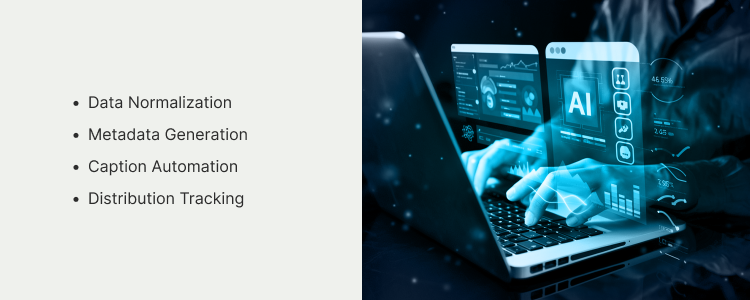
Artificial intelligence is rapidly transforming the entertainment industry, opening up new frontiers for creativity, efficiency, and audience engagement. From scriptwriting and video editing to personalized content recommendations and virtual performers, AI technologies are being woven into nearly every aspect of media and entertainment.
Today’s top studios, streaming platforms, and gaming companies are using powerful AI tools not just behind the scenes—but to shape the entertainment experiences we consume every day. These tools support content creation by automating repetitive production tasks, generating realistic effects, and enhancing creative workflows.
On the consumer side, AI in entertainment helps personalize recommendations, target ads more precisely, and deliver immersive, interactive experiences that adapt to individual preferences.
As media companies strive to stay competitive in a digital-first landscape, artificial intelligence is no longer optional—it’s a strategic advantage. If it’s analyzing audience behavior to fine-tune future releases or creating lifelike digital influencers, AI is redefining how entertainment is made, distributed, and experienced.
What Is AI in Entertainment?
AI in entertainment refers to the use of artificial intelligence technologies—such as machine learning, neural networks, and data-driven algorithms—to enhance and automate processes across the entertainment industry. From assisting creative professionals with content creation to optimizing how audiences discover and interact with media, AI plays an increasingly central role in shaping entertainment experiences.
If it’s writing scripts, editing footage, composing music, or curating personalized content feeds, AI models are changing how media is produced and consumed. These tools allow entertainment companies to streamline workflows, make smarter creative decisions, and better align their offerings with audience demand.
Here’s how AI is applied in the entertainment business:
- AI models and algorithms help generate, edit, and enhance content across film, TV, music, and gaming.
- Creative professionals now use AI as a collaborative tool for brainstorming ideas, refining production quality, and speeding up tedious tasks.
- Media and entertainment companies leverage AI for everything from content recommendation systems to digital marketing and operational efficiency.
- Machine learning systems continuously analyze user behavior, enabling hyper-personalized entertainment experiences at scale.
As AI technologies continue to evolve, they’re not just supporting the entertainment industry—they’re redefining its creative and commercial possibilities.
How AI Is Used in Content Creation and Production

AI is transforming the way content is created in the entertainment industry, helping professionals streamline tasks and push creative boundaries. From initial story ideas to final visual polish, AI tools play a major role in enhancing efficiency and expanding what’s possible in media production.
Scriptwriting and Story Development
Generative AI tools are making waves in the early stages of content creation by helping writers develop storylines, characters, and dialogue. These tools use natural language processing (NLP) and advanced AI algorithms to analyze vast amounts of literary material—screenplays, books, and scripts—and generate new content in response to user prompts.
Whether you’re a writer looking for creative inspiration or a production company seeking a draft outline, AI-generated material can accelerate the storytelling process without replacing human insight.
AI in Video Editing and Post Production
Post-production is one of the most time-consuming stages of content creation, but AI tools are making it significantly faster and more efficient. Modern video editing software now includes AI-powered tools that automate scene detection, metadata tagging, captioning, and even complex tasks like color grading. By automating repetitive tasks, media companies can shorten editing cycles, reduce costs, and focus more on creative refinement and storytelling impact.
Music Generation and Sound Engineering
AI is also reshaping music production by generating background scores, identifying musical styles, and even composing original melodies. If you’re producing a film soundtrack, a video game theme, or a podcast intro, AI-generated music offers a cost-effective, fast, and surprisingly adaptive solution. These tools help improve sound quality and expand access to professional-grade audio for creators of all levels, making music generation more inclusive and accessible.
Visual Effects and Animation
In animation and VFX-heavy productions, AI is becoming a game-changer. AI capabilities now include generating hyper-realistic visual effects, creating digital replicas of actors, and even developing synthetic performances using deepfake technology.
These innovations not only reduce the time and expense of manual animation but also unlock new creative possibilities that were once considered out of reach. From blockbuster films to indie games, AI is pushing visual storytelling into the future.
Personalization: AI’s Role in Enhancing Viewer Experience
One of the most visible ways AI is transforming entertainment is through personalized content recommendations. Streaming services and platforms like Netflix, Hulu, Spotify, and YouTube rely heavily on machine learning algorithms to analyze user preferences, viewing habits, and behavioral patterns. These AI-powered tools help media companies serve up content that feels tailor-made for each individual viewer.
By tracking data points like watch history, pause rates, search behavior, and even time of day, AI algorithms can predict what a user is most likely to enjoy next. This personalization not only enhances viewer satisfaction but also keeps users engaged longer—driving loyalty and boosting platform retention.
For content creators and distributors, this data-driven approach helps refine what gets produced, promoted, or retired. In a landscape saturated with options, AI enables smarter content delivery that aligns perfectly with evolving audience tastes—offering entertainment that feels intuitive, relevant, and instantly gratifying.
AI in Streaming Services and Recommendations
Streaming platforms like Netflix, YouTube, and Spotify rely heavily on AI-powered recommendation engines to deliver content that feels instantly relevant to each user. These engines use complex algorithms and behavioral data to suggest videos, shows, or songs based on what a viewer has watched, liked, skipped, or searched for—often in real time.
By applying machine learning to vast data sets, these platforms can go beyond basic categorization and offer deeply personalized entertainment experiences. This not only enhances user satisfaction but also increases overall watch time and engagement, which is critical for subscriber retention.
Here’s how AI enhances streaming services:
- Real-time personalization – Instantly adapts content feeds based on evolving user behavior and preferences.
- Predictive content suggestions – Recommends what users are most likely to watch or listen to next, based on past interactions and similar audience profiles.
- Ad targeting – Delivers more relevant ads by aligning marketing messages with user interests, demographics, and viewing patterns.
These AI-powered systems are now central to content creation and distribution strategies, helping media companies maximize viewer engagement and monetize content more effectively across streaming platforms.
AI in Gaming and Interactive Entertainment
The gaming industry has long been at the forefront of adopting AI technologies, using them to create more dynamic, immersive, and personalized experiences. Today, artificial intelligence plays a central role in everything from world-building to character behavior, transforming how players interact with video games.
One of the most impactful uses is procedural content generation, where AI algorithms automatically generate environments, levels, or scenarios based on gameplay data. This allows developers to offer endless replayability and fresh experiences without manually designing every detail. Games like Minecraft and No Man’s Sky are prime examples of how AI-driven content expands creative possibilities.
AI also enables adaptive gameplay, where the difficulty level or narrative direction shifts in real time based on player behavior. This ensures that each session feels unique and tailored, improving user engagement and satisfaction. In story-driven games, AI helps power user-driven narratives by allowing characters to respond more intelligently to player decisions, creating a more emotionally resonant experience.
Even in sound design, AI is contributing through generated music that adapts to gameplay pace or emotional tone, further enhancing immersion. As the lines between gaming, storytelling, and simulation continue to blur, AI in entertainment is unlocking unprecedented levels of interactivity and personalization for players around the world.
How Media Companies Use AI for Audience Analysis

In today’s data-driven landscape, media companies are increasingly turning to AI technologies to better understand their audiences and make smarter content decisions. Through advanced tools like natural language processing (NLP), machine learning, and behavioral analytics, AI enables precise and scalable audience analysis that was previously impossible.
These systems track how viewers interact with content—what they watch, when they watch it, and how they respond emotionally or behaviorally. For instance, sentiment analysis can evaluate viewer reactions to trailers, social media posts, or full-length episodes by analyzing comments, likes, and shares. This helps platforms gauge public opinion in real time.
AI also gathers and interprets vast amounts of data points, such as watch duration, device usage, and click-through rates, to deliver valuable insights into what types of content resonate with different demographics. Companies like Netflix and Disney use these insights to refine programming, schedule releases, and develop storylines that align with proven viewer interests.
By leveraging AI for audience analysis, media companies can move beyond gut instinct and base their strategies on predictive, performance-based intelligence—creating content that not only reaches audiences but deeply connects with them.
Targeted Marketing and Ad Campaigns Powered by AI
AI is reshaping how entertainment companies design and deliver their marketing campaigns, making them smarter, more personalized, and significantly more effective. By analyzing vast datasets in real time, AI-driven tools enable brands to understand audience preferences, track consumer behavior, and deliver highly tailored messages across multiple platforms.
In the media industry, predictive analytics allows marketing teams to anticipate trends, identify demand patterns, and segment audiences with precision. For example, AI can help determine which trailer will resonate best with a specific demographic or when to launch an advertising campaign for maximum impact. These insights result in data-driven strategies that increase engagement and improve ROI.
Additionally, AI tools power dynamic ad targeting—where content and offers adapt automatically based on user behavior, location, or viewing history. If it’s a personalized email campaign or a sponsored post on a streaming platform, every touchpoint is optimized for relevance and conversion.
As media companies compete for attention in a crowded digital landscape, AI-powered advertising campaigns offer a major advantage: reaching the right people with the right message at the right time.
AI and the Rise of Virtual Influencers and Synthetic Performers
One of the most fascinating developments in AI-driven entertainment is the emergence of virtual influencers and synthetic performers—digitally created personalities powered by artificial intelligence. These characters are designed to interact with audiences on social media, appear in advertisements, host live events, or even star in films and music videos, all without a human counterpart behind the scenes.
With advanced AI capabilities, these virtual figures can respond to comments, generate lifelike expressions, and maintain cohesive brand identities. Some are fully animated using motion-capture technology, while others are built entirely through AI-generated modeling and scripting. In either case, they offer new ways for brands and creative professionals to craft unique, controlled entertainment experiences.
As virtual reality and digital media converge, synthetic performances are gaining popularity among younger, digitally native audiences. They provide novelty, scalability, and creative flexibility—allowing companies to experiment with personas that never age, misstep, or require traditional management. From pop stars like Lil Miquela to digital ambassadors for fashion and gaming brands, virtual influencers are redefining the boundaries of fame and storytelling in the modern media landscape.
AI in Virtual and Augmented Reality Experiences
AI is playing a pivotal role in enhancing virtual and augmented reality by making immersive environments more intelligent, responsive, and lifelike. In the media and entertainment sector, these technologies are converging to create deeply engaging experiences for users across live events, gaming, education, and even training simulations.
Through AI, virtual worlds can adapt in real time to user behavior—changing environments, dialogue, or challenges based on individual interaction. In live concerts or VR festivals, AI helps sync lighting, sound, and crowd dynamics to deliver more personalized and memorable entertainment experiences. In gaming, AI-driven avatars and environments enhance realism, while in educational settings, AI customizes content delivery for more effective learning outcomes.
What sets these experiences apart are the creative aspects AI enables—designing intelligent NPCs (non-playable characters), adjusting storylines dynamically, and supporting world-building that reacts and evolves based on player or viewer input. As AI technologies mature, they’re not just enriching the VR/AR experience—they’re turning passive audiences into active participants.
Automation and Operational Use of AI in the Entertainment Sector

Beyond creativity, AI plays a critical role in streamlining operations for media and entertainment companies. From organizing massive libraries of content to optimizing distribution workflows, AI-powered tools help reduce human workload and increase efficiency across the board.
These systems are designed to automate routine tasks that once required significant manual labor—freeing up teams to focus on higher-value creative and strategic work. Here’s how AI-driven automation supports day-to-day operations in modern media production:
- Data Normalization
AI ensures consistency across diverse datasets by cleaning, organizing, and standardizing incoming information—making it easier to manage large volumes of media content. - Metadata Generation
Automatically tagging videos, images, and audio files with relevant keywords, descriptions, and timestamps helps streamline search, categorization, and content management. - Caption Automation
AI can generate accurate closed captions and subtitles in multiple languages, enhancing accessibility and saving editors hours of manual transcription. - Distribution Tracking
AI tools monitor where and how content is distributed across platforms, tracking performance metrics and flagging delivery issues in real time.
For production houses and platforms handling thousands of assets daily, automation through AI is no longer just a convenience—it’s a necessity for staying competitive and agile.
Legal and Ethical Challenges of AI in Entertainment

As AI becomes more embedded in the entertainment industry, it brings with it a wave of complex legal and ethical questions. From content ownership to consent, the rise of AI-generated content challenges existing frameworks for copyright and intellectual property.
One major concern is the growing use of synthetic performances and deepfake technology, which can recreate the likeness of real people—sometimes without their permission. This raises serious issues around digital identity, actor rights, and personal consent, especially when used in commercial or explicit contexts.
For human writers and other creative professionals, AI also introduces the risk of job displacement, as algorithms begin to take over tasks like scriptwriting, video editing, and music generation. While AI can support the creative process, it can also devalue original human input if misused or unregulated.
There’s also the question of data security—how platforms collect and use consumer behavior data to power personalization and automation. Without transparent data policies, user privacy may be compromised in the pursuit of engagement and profit.
As AI reshapes the legal and ethical boundaries of entertainment, media companies must navigate this evolving landscape carefully, balancing innovation with responsibility and respect for human creativity.
Impact on Creative Professionals
For writers, artists, musicians, and editors, the rise of AI in entertainment presents both significant challenges and exciting opportunities. On one hand, AI tools can automate routine tasks—like transcribing dialogue, editing clips, or tagging media—freeing up time for creators to focus on the more creative aspects of their work. This support can boost productivity, reduce burnout, and streamline production workflows.
However, many creative professionals are understandably concerned about being replaced or devalued by machines. As AI becomes more capable of generating text, music, and visuals, questions arise about the role of human creativity in future content production. There’s a growing tension between embracing AI as a collaborator versus seeing it as a competitor.
At the same time, AI can empower other creative professionals—those without formal training or expensive tools—to enter the industry and create high-quality content more easily. By lowering technical barriers, AI democratizes creativity and expands who can participate in the entertainment landscape.
Ultimately, the impact of AI depends on how it’s implemented. When used ethically and thoughtfully, AI can serve as a powerful ally—augmenting human talent rather than replacing it.
Future Trends for AI in Media and Entertainment
As technology continues to evolve, the role of AI in the entertainment and media industry is poised to expand in transformative ways. From content development to real-time engagement, the future of entertainment will be deeply shaped by machine learning and intelligent automation.
Here are some key trends to watch in the coming years:
- Generative AI’s evolution in storytelling
As generative AI becomes more sophisticated, it will play a larger role in co-creating scripts, narratives, and even fully interactive story worlds tailored to individual users. - AI in real-time media production
Live broadcasting, virtual concerts, and interactive performances will increasingly use AI to manage production elements on the fly—adjusting visuals, audio, and pacing based on audience response in real time. - Deeper personalization across platforms
Personalization will go beyond recommendations to include AI-curated viewing schedules, adaptive soundtracks, and custom story arcs that evolve with each viewer’s preferences and mood. - Emotion-aware content delivery
AI systems may soon detect emotional cues through facial recognition or biometric data, adjusting entertainment experiences accordingly for deeper immersion. - Synthetic characters and hosts
Expect more AI-generated influencers, talk show hosts, and virtual brand ambassadors to take center stage—especially in marketing, gaming, and virtual worlds. - Voice cloning and AI dubbing
With AI-powered voice synthesis, content can be instantly localized for different languages and regions while preserving the emotional tone and delivery of the original performance. - Increased accessibility
AI tools will improve accessibility for differently-abled audiences through automatic translations, real-time captioning, and AI-driven sign language interpretation.
The integration of AI in media and entertainment isn’t just a trend—it’s a paradigm shift. As these technologies mature, they will redefine how content is imagined, produced, and experienced across every corner of the entertainment industry.
FAQs About AI in Entertainment
How is AI used in the entertainment industry?
AI in entertainment is used to automate production tasks, personalize viewer experiences, generate content like scripts or music, and analyze audience behavior. Across the media and entertainment sector, AI tools help streamline operations and fuel innovation in storytelling, marketing, and user engagement.
Is AI a threat to the entertainment industry?
AI isn’t inherently a threat, but its rapid growth raises concerns about job displacement and over-reliance on automation. If managed ethically, it can support rather than replace human talent, helping the entertainment industry evolve rather than shrink.
What are some examples of AI-generated content?
Examples include AI-generated content like music compositions, virtual influencers, deepfake performances, and automatically written scripts. Tools can now produce generated music and other AI-generated material that’s used in films, games, and online media.
Can AI replace human creatives in entertainment?
While AI can replicate certain tasks, it lacks the emotional nuance and originality of human writers and other creative professionals. At best, it complements human creativity rather than replacing it—serving as a tool to enhance artistic output.
What are the risks of using AI in entertainment?
Key risks include job displacement, misuse of personal likeness through deepfakes, and challenges around data security and intellectual property. Without clear legal frameworks, AI-generated work can blur ownership and ethical boundaries.























